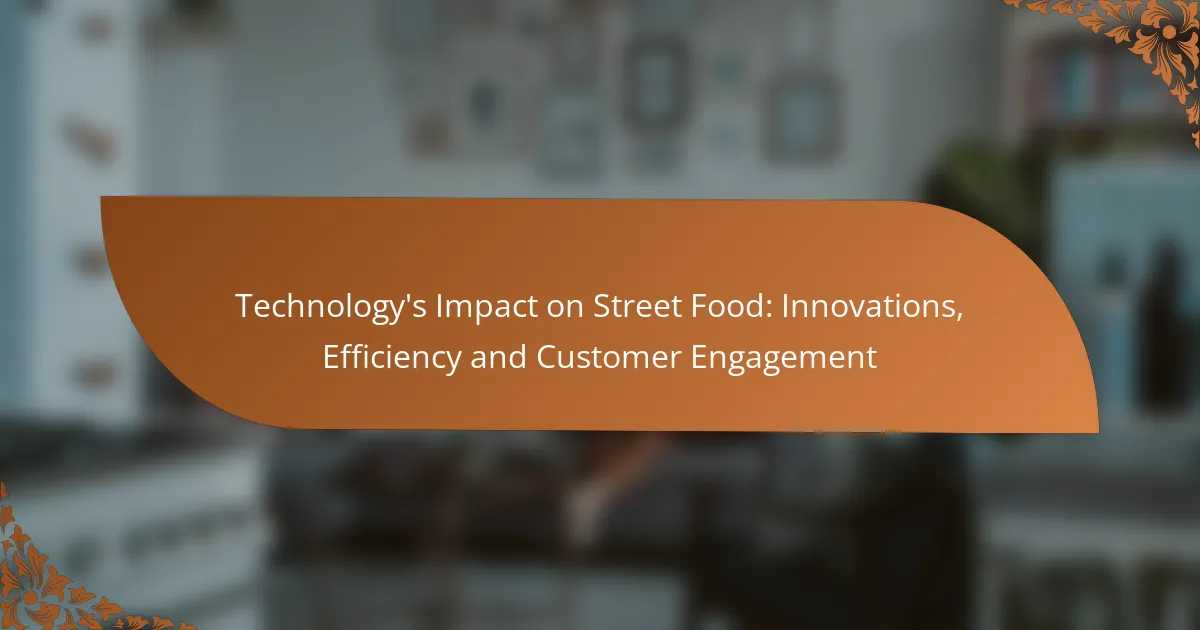Technology is revolutionizing the street food scene by enhancing operational efficiency and customer engagement. With innovations like mobile payment systems and automated cooking equipment, vendors can serve customers more quickly and effectively, while tools such as food delivery apps and interactive kiosks create a more personalized dining experience. These advancements are not only streamlining operations but also reshaping how customers interact with street food offerings.
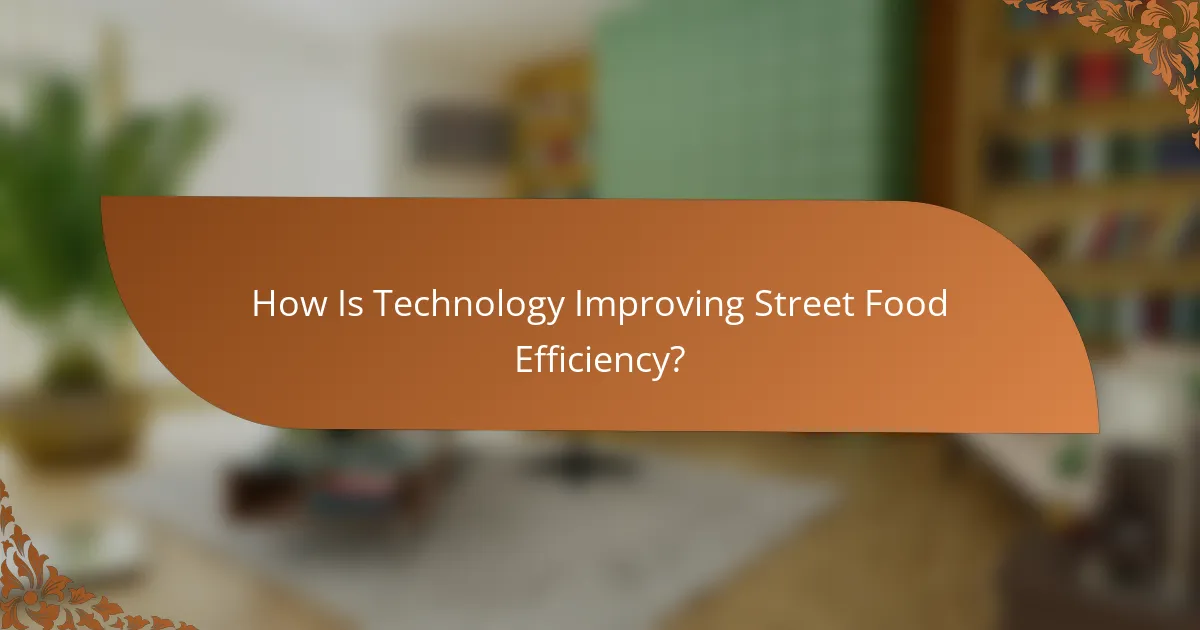
How Is Technology Improving Street Food Efficiency?
Technology significantly enhances street food efficiency by streamlining operations, reducing wait times, and improving customer interactions. Innovations such as mobile payment systems and automated cooking equipment allow vendors to serve customers faster while managing resources more effectively.
Mobile payment systems
Mobile payment systems simplify transactions for street food vendors and customers alike. By accepting payments through apps like Apple Pay, Google Wallet, or local alternatives, vendors can reduce cash handling and speed up the checkout process.
These systems often integrate with sales tracking software, allowing vendors to monitor sales trends and customer preferences. This can lead to better inventory management and targeted promotions.
Smart inventory management
Smart inventory management utilizes technology to track stock levels in real-time, helping street food vendors minimize waste and optimize their supply chain. By using apps or software that alert vendors when supplies are low, they can ensure they always have the necessary ingredients on hand.
Some systems even analyze sales data to predict future inventory needs based on trends, allowing vendors to make informed purchasing decisions. This proactive approach can lead to cost savings and improved menu offerings.
Automated cooking equipment
Automated cooking equipment, such as programmable fryers and grills, enhances efficiency by ensuring consistent cooking times and temperatures. This technology allows vendors to prepare food more quickly and with less manual oversight, freeing them to focus on customer service.
Additionally, these devices often come with energy-saving features, which can reduce operational costs. Investing in such equipment can lead to higher throughput during peak hours, improving overall profitability.
Real-time order tracking
Real-time order tracking systems provide customers with updates on their food preparation and delivery status. This transparency helps manage customer expectations and reduces perceived wait times.
By using apps that allow customers to track their orders, vendors can enhance customer satisfaction and encourage repeat business. This feature is particularly effective in busy urban areas where competition is high.
Data analytics for sales optimization
Data analytics tools enable street food vendors to analyze sales patterns and customer behavior. By examining data on peak sales times, popular menu items, and customer demographics, vendors can make strategic decisions to optimize their offerings.
For example, vendors can adjust their menus based on seasonal trends or introduce promotions during slower periods. Utilizing data effectively can lead to increased sales and improved customer engagement.
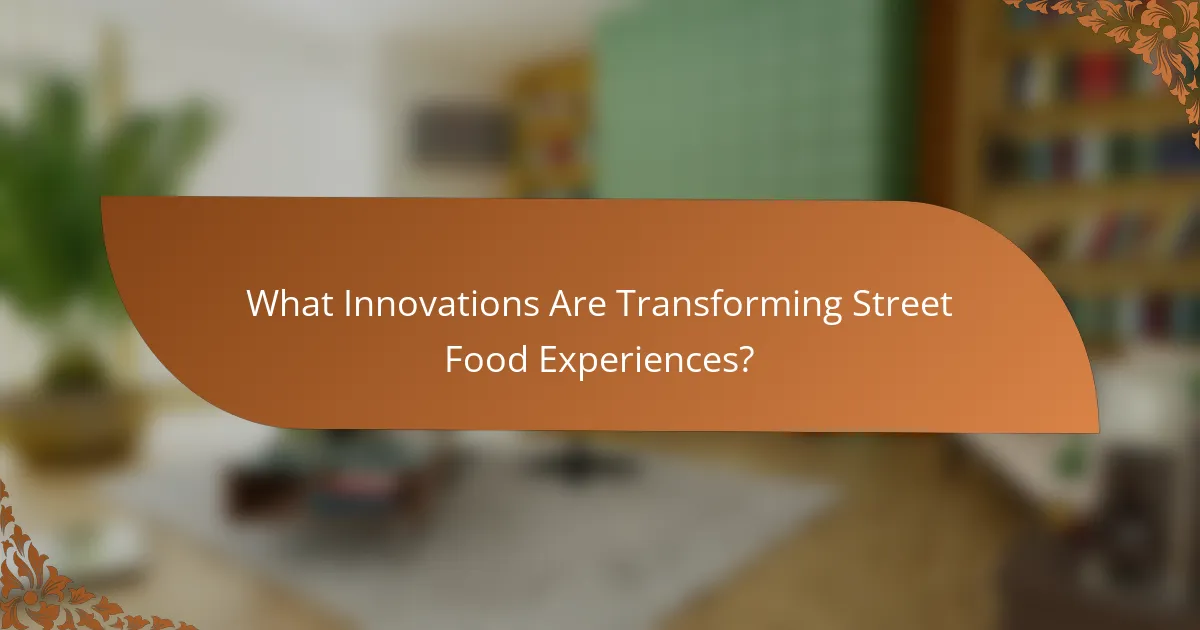
What Innovations Are Transforming Street Food Experiences?
Innovations in technology are significantly enhancing street food experiences by improving efficiency, customer engagement, and overall convenience. From food delivery apps to blockchain for food safety, these advancements are reshaping how vendors operate and how customers interact with street food offerings.
Food delivery apps
Food delivery apps have revolutionized the street food landscape by allowing customers to order from their favorite vendors with ease. These platforms, such as Uber Eats and DoorDash, enable quick access to a variety of street food options, often with delivery times under 30 minutes.
Vendors can expand their reach beyond foot traffic, tapping into a larger customer base. However, they should consider the commission fees charged by these apps, which can range from 15% to 30%, impacting profit margins.
Augmented reality menus
Augmented reality (AR) menus are enhancing customer engagement by providing interactive dining experiences. Customers can use their smartphones to visualize dishes before ordering, helping them make informed choices.
This technology can also showcase ingredients and preparation methods, appealing to health-conscious consumers. Vendors should ensure their AR content is user-friendly and visually appealing to maximize its impact.
Social media marketing strategies
Social media marketing is crucial for street food vendors to connect with customers and promote their offerings. Platforms like Instagram and Facebook allow vendors to share enticing photos, engage with followers, and announce special promotions.
Effective strategies include posting regularly, utilizing hashtags, and collaborating with local influencers. Vendors should focus on creating visually appealing content to attract attention and drive foot traffic to their locations.
Online ordering platforms
Online ordering platforms streamline the purchasing process for street food customers. These systems enable pre-ordering, reducing wait times and improving customer satisfaction.
Vendors can integrate these platforms with their existing operations, allowing for better inventory management and sales tracking. It’s essential to choose a reliable platform that offers user-friendly interfaces and secure payment options.
Blockchain for food safety
Blockchain technology is emerging as a tool for enhancing food safety in the street food sector. By providing a transparent and immutable record of food sourcing and handling, it helps ensure that vendors meet safety standards.
Implementing blockchain can build customer trust, as consumers increasingly prioritize food safety and traceability. Vendors should consider partnering with tech providers to establish a blockchain system that suits their operational needs.
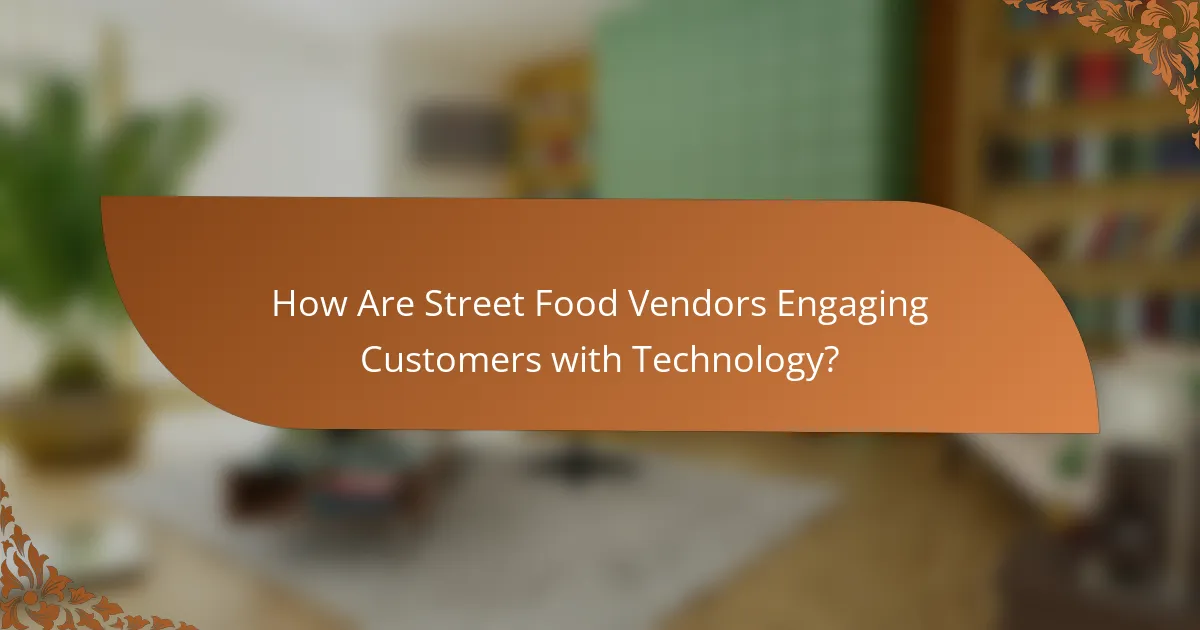
How Are Street Food Vendors Engaging Customers with Technology?
Street food vendors are increasingly using technology to enhance customer engagement through interactive experiences and personalized services. By leveraging tools like kiosks, mobile apps, and feedback systems, vendors can create a more efficient and enjoyable dining experience.
Interactive kiosks
Interactive kiosks allow customers to place orders and make payments without needing to interact directly with staff. These kiosks can streamline the ordering process, reduce wait times, and minimize human error, enhancing overall efficiency.
For example, a street food vendor might install a touchscreen kiosk that displays the menu, allows customization, and processes payments. This not only speeds up service but also provides a modern touch that can attract tech-savvy customers.
Loyalty programs through apps
Loyalty programs integrated into mobile apps encourage repeat business by rewarding customers for their purchases. These programs can offer discounts, free items, or exclusive deals, fostering a sense of community and customer loyalty.
Vendors can implement simple app-based systems where customers earn points for each purchase, redeemable for rewards. This approach not only incentivizes repeat visits but also allows vendors to collect valuable data on customer preferences and behaviors.
Customer feedback systems
Customer feedback systems enable vendors to gather insights on their food and service quality. By utilizing digital surveys or feedback forms, vendors can quickly assess customer satisfaction and identify areas for improvement.
For instance, a vendor might send a follow-up message through an app after a purchase, asking for a rating or comments. This immediate feedback loop helps vendors adapt their offerings to meet customer needs better and can lead to higher satisfaction and retention rates.
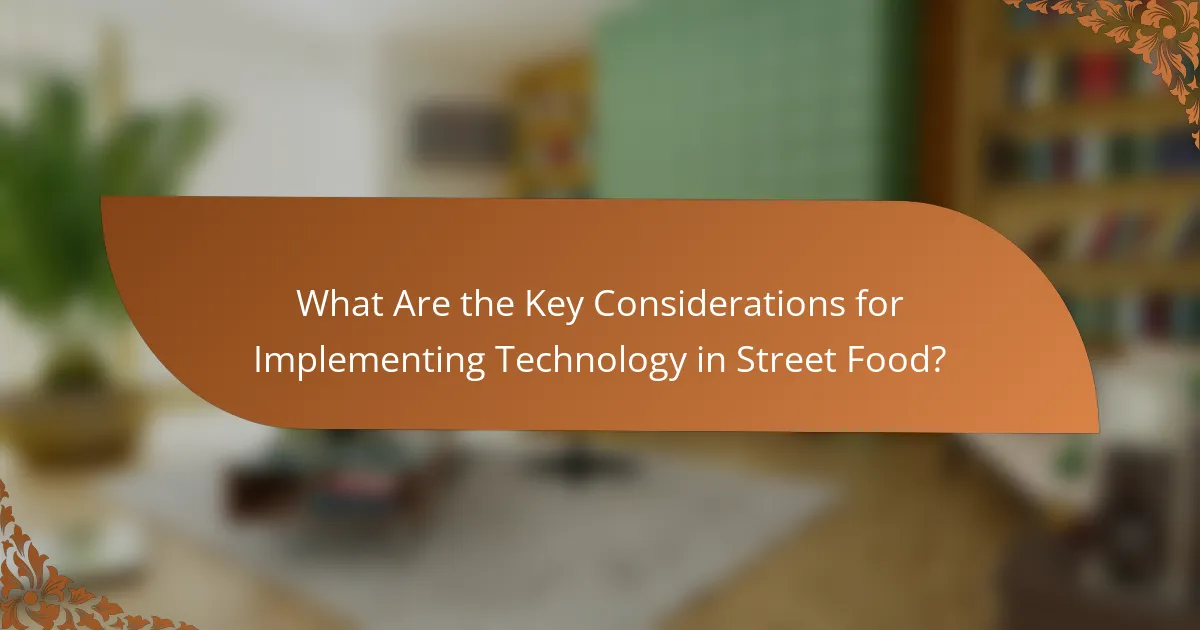
What Are the Key Considerations for Implementing Technology in Street Food?
Implementing technology in street food requires careful consideration of costs, staff training, and integration with existing operations. Each of these factors plays a crucial role in ensuring a smooth transition and maximizing the benefits of technological advancements.
Cost of technology adoption
The cost of adopting technology in street food can vary widely based on the type of systems implemented. Basic point-of-sale (POS) systems may start at a few hundred USD, while more advanced solutions, including mobile ordering and inventory management, can reach several thousand USD. It’s essential to assess the potential return on investment (ROI) to justify these expenses.
Consider budgeting for ongoing costs such as software subscriptions, maintenance, and potential upgrades. A clear financial plan will help manage these expenses effectively and avoid unexpected financial strain.
Training staff on new systems
Training staff on new technology is critical for successful implementation. Allocate time and resources for comprehensive training sessions to ensure that all employees are comfortable using the new systems. This may include hands-on workshops, online tutorials, or one-on-one coaching.
Be mindful of the varying tech-savviness of your team. Tailoring training methods to different skill levels can enhance learning outcomes and reduce resistance to change. Regular refresher courses can also help maintain proficiency over time.
Integration with existing operations
Integrating new technology with existing street food operations is vital for seamless functionality. Evaluate how the new systems will interact with current processes, such as order taking, payment processing, and inventory management. Ensuring compatibility can prevent disruptions and improve efficiency.
Consider phased implementation to minimize operational impact. Start with one aspect of your business, such as a new POS system, before rolling out additional technologies. This approach allows for troubleshooting and adjustments without overwhelming staff or customers.
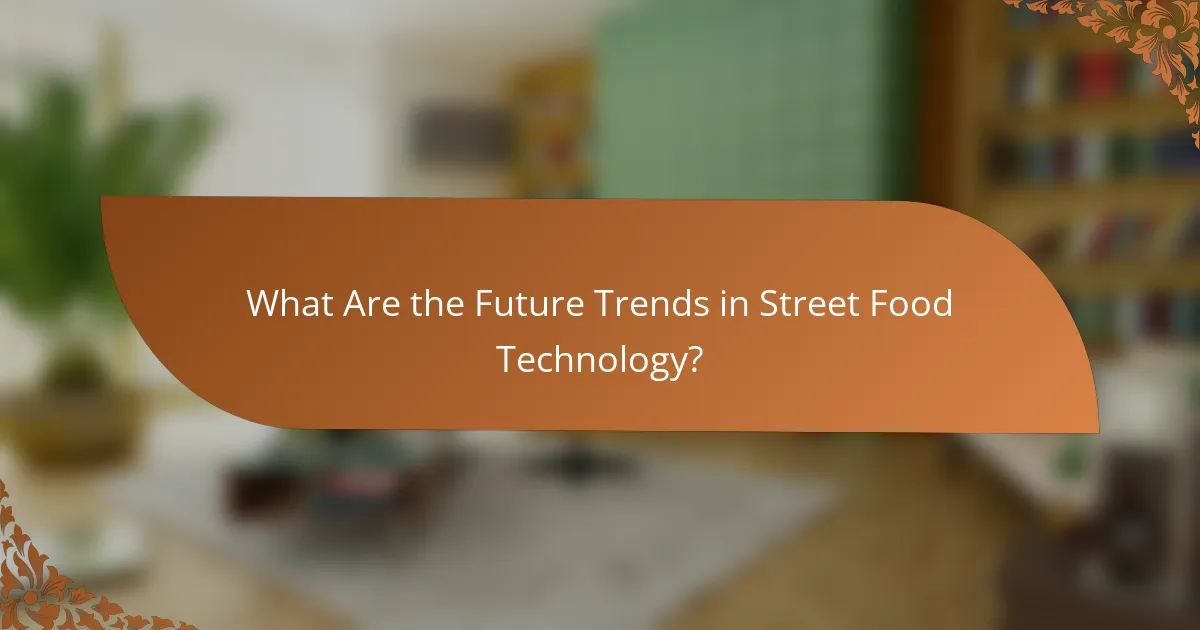
What Are the Future Trends in Street Food Technology?
The future of street food technology is set to enhance efficiency, customer engagement, and overall dining experiences. Innovations such as mobile ordering, smart payment systems, and food tracking are transforming how vendors operate and interact with customers.
Mobile Ordering and Delivery Services
Mobile ordering is becoming increasingly popular in the street food sector, allowing customers to place orders via apps before arriving. This technology reduces wait times and improves customer satisfaction by streamlining the ordering process.
Street food vendors can partner with delivery services to expand their reach. This not only increases sales but also allows vendors to cater to a broader audience who may prefer dining at home or in the office.
Smart Payment Solutions
Smart payment solutions, including contactless payments and mobile wallets, are revolutionizing transactions in street food. These methods speed up the checkout process and enhance security, making it easier for customers to pay without cash.
Vendors should consider adopting multiple payment options to accommodate various customer preferences. This flexibility can lead to increased sales and a better customer experience.
Food Tracking and Transparency
Food tracking technology is gaining traction, allowing customers to trace the origin of their meals. This transparency builds trust and can be a significant selling point for health-conscious consumers.
Vendors can leverage this technology by providing information about ingredient sourcing and preparation methods. Engaging customers with stories about their food can enhance loyalty and encourage repeat business.
